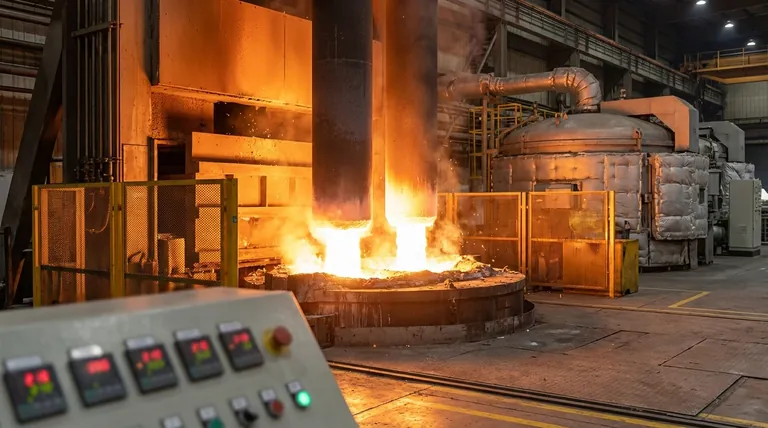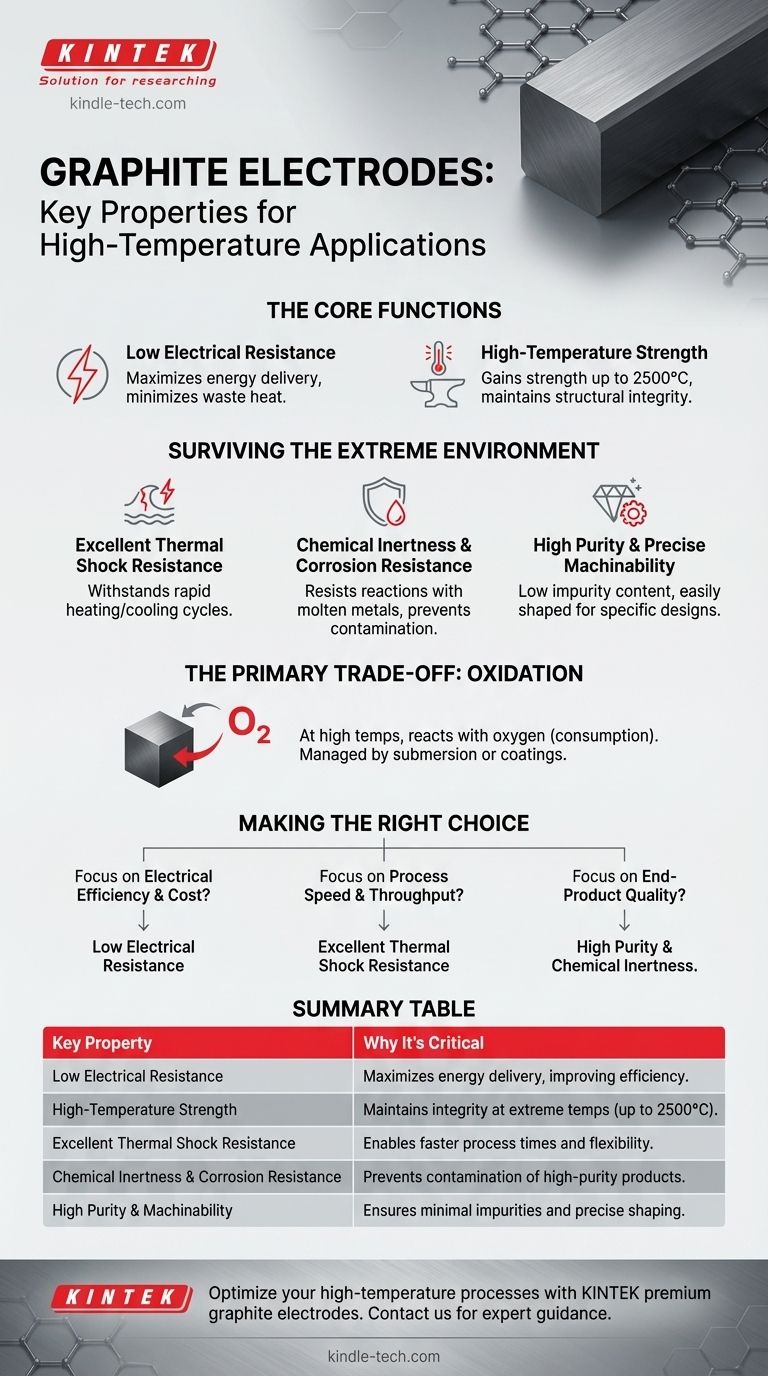For high-temperature electrode applications, the most critical properties of graphite are its exceptional resistance to thermal shock, high-temperature strength, and low electrical resistance. This unique combination allows it to conduct massive amounts of electricity in extreme heat while withstanding the rapid temperature cycles common in industrial processes.
The true value of graphite isn't found in any single characteristic, but in the rare synergy of its properties. It simultaneously performs the electrical function of an electrode while surviving an environment that would destroy most other materials.

The Core Functions of an Electrode
To understand why graphite is the default choice, we must first analyze the fundamental demands placed on a high-temperature electrode. Its job is to deliver electrical energy efficiently while maintaining its structural integrity in a hostile environment.
Low Electrical Resistance
An electrode's primary purpose is to conduct electricity. Graphite's low electrical resistance ensures that the maximum amount of energy is delivered to the target material (like molten metal) rather than being lost as waste heat within the electrode itself.
This electrical efficiency is paramount for minimizing energy consumption and controlling the process temperature with precision.
High-Temperature Strength
Unlike metals that melt or soften, graphite has an extremely high sublimation point (around 3652°C) and actually gains strength as temperature increases up to about 2500°C.
This property ensures the electrode maintains its shape and structural integrity, preventing deformation or failure when operating at the white-hot temperatures required in applications like electric arc furnaces.
Surviving the Extreme Environment
Beyond its core functions, an electrode must be durable enough to survive the operational environment. This is where graphite's thermo-mechanical and chemical properties become critical.
Excellent Thermal Shock Resistance
Thermal shock is the stress a material endures when it undergoes rapid temperature changes. The ability to heat up and cool down quickly without cracking is graphite's most distinguished trait for this use case.
This resistance is vital for reducing process cycle times. An electrode that can be rapidly introduced and removed from extreme heat allows for more efficient and faster production.
Chemical Inertness & Corrosion Resistance
At high temperatures, many materials become highly reactive. Graphite exhibits excellent corrosion resistance and is chemically inert in contact with many molten metals and slag.
This ensures the electrode does not contaminate the material being processed, which is essential for producing high-purity products like steel alloys.
High Purity and Precise Machinability
High-grade graphite can be produced with a very low impurity content, further preventing contamination of the final product.
Additionally, it can be easily machined into the precise and often complex shapes required for different furnace designs, ensuring optimal electrical contact and performance.
Understanding the Primary Trade-off: Oxidation
While graphite's properties make it nearly ideal, it has one significant vulnerability that must be managed in any application.
The Impact of Oxygen
Graphite is a form of carbon. At high temperatures, it will react with oxygen in the air and oxidize, essentially burning away like charcoal. This process, known as consumption, is the primary factor in an electrode's lifespan.
Mitigation Strategies
This trade-off is managed through operational design. In many processes, the tip of the electrode is submerged in a material (like molten slag) that protects it from the atmosphere. Protective coatings can also be applied to minimize oxidation.
Understanding and managing electrode consumption is a critical aspect of process efficiency and cost control.
Making the Right Choice for Your Goal
The "most important" property depends entirely on your primary operational objective.
- If your primary focus is electrical efficiency and cost: Low electrical resistance is the most critical factor to minimize energy loss.
- If your primary focus is process speed and throughput: Excellent thermal shock resistance is paramount to allow for rapid heating and cooling cycles.
- If your primary focus is end-product quality: High purity and chemical inertness are non-negotiable to prevent contamination.
Ultimately, graphite's unique combination of electrical, thermal, and mechanical properties makes it the indispensable material for high-temperature electrode applications.
Summary Table:
| Key Property | Why It's Critical for Electrodes |
|---|---|
| Low Electrical Resistance | Maximizes energy delivery to the target material, reducing waste heat and improving efficiency. |
| High-Temperature Strength | Maintains structural integrity and shape at extreme temperatures (up to 2500°C), preventing failure. |
| Excellent Thermal Shock Resistance | Withstands rapid heating/cooling cycles, enabling faster process times and operational flexibility. |
| Chemical Inertness & Corrosion Resistance | Prevents contamination of high-purity products like steel alloys by resisting reactions with molten materials. |
| High Purity & Machinability | Ensures minimal impurities and allows for precise shaping to fit specific furnace designs and requirements. |
Optimize your high-temperature processes with the right graphite electrodes. At KINTEK, we specialize in providing high-performance lab equipment and consumables, including premium graphite electrodes tailored for demanding applications. Whether your priority is energy efficiency, process speed, or product purity, our solutions are designed to enhance your lab's productivity and reliability. Contact us today to discuss your specific needs and discover how KINTEK can support your success with top-tier materials and expert guidance.
Visual Guide

Related Products
- Graphite Vacuum Furnace High Thermal Conductivity Film Graphitization Furnace
- Vertical High Temperature Graphite Vacuum Graphitization Furnace
- 2200 ℃ Graphite Vacuum Heat Treat Furnace
- Graphite Vacuum Continuous Graphitization Furnace
- Electrode Polishing Material for Electrochemical Experiments
People Also Ask
- What are the advantages of graphite? Unlock Superior Performance in High-Temperature Processes
- What temperature can graphite withstand? Unlocking Its Extreme Heat Potential
- What is the temperature range of a graphite furnace? Unlock up to 3000°C for advanced materials processing.
- What are the advantages of graphite furnace? Achieve High-Temperature Precision and Purity
- What are the applications of graphite material? Leveraging Extreme Heat and Precision for Industrial Processes



















